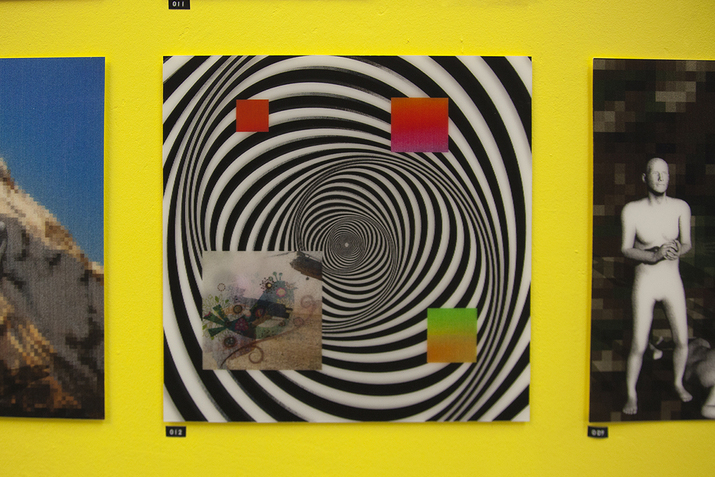-
From Current Issue
-
- Editor’s Letter Fire in the Heart
- Reviews I Gusti Ayu Kadek Murniasih
- Reviews 11th Seoul Mediacity Biennale: “One Escape at a Time”
- Dispatch Networked China
- One on One Monira Al Qadiri on Yukio Mishima
- Essays The rise of independent art spaces in pandemic-era Shanghai
- Features Tuan Andrew Nguyen
- Table of Contents
- Web Exclusives
- Archive
- Subscribe

R
E
V N
E
X
T
SULAFA HIJAZI, (left) Branding, 2016, lenticular print, 60 × 60 cm; (right) Scarecrow, lenticular print, 60 × 60 cm. Courtesy the artist.
In Sulafa Hijazi’s “Animated Images 002,” showing at London’s Rich Mix as part of the two-week Shubbak festival of Arab art and culture, the Berlin-based, Syrian artist marries a powerful if at times simplistic political sensibility with the wry humor and idiosyncratic aesthetic of much contemporary digital art.
The exhibition consists of two series of prints and a video installation, all starring colorless, hairless, digitally rendered mannequins. The pictures in both series employ lenticular printing technology, which produces images that appear to change or move as the viewer repositions his or herself in relation to them. In Untitled (2016), Hijazi offers her mannequins against black backgrounds in various scenes and situations, incorporating appropriated digital imagery to support her social commentary. In Scarecrow(2016), the eponymous effigy is dressed in a thobe, and in Branding (2016) a figure patterned with out-of-focus images wears an oversized tag around his neck reading “Refugee.” In these pieces, the pertinent themes in the artist’s works are presented rather than explored. Although the appearance of the prints may change depending on the position from which they are viewed, it’s questionable whether the political perspectives they reveal are so nuanced.
However, the artist’s socially focused work is more nuanced. Hug (2016) shows a mannequin kneeling, embracing a heavily simplified pixel-person and stroking it with a hand that moves with the viewer’s perspective. It’s an image of strangely touching vulnerability, with this figure attaching himself to a crude likeness of humanity as though it were his only escape from loneliness. In the adjacent F*ck (2016), then, where the same figure holds his inanimate companion diagonally and humps the side of its head, human fickleness and frailty come to the fore. The result is funny, critical, forgiving and therefore human in a way the more expressly political works fail to be. In a quasi-political vein, however, Hijazi does successfully critique our relationship with technology.
In Loading. . . Please Wait (2016), at the center of a simple black square lies the loading symbol from a Mac computer, which turns as the viewer passes. It only takes a moment of surging Pavlovian frustration to realize, with a degree of self-disgust, just how dependent on machines many of us have become.
A more recent series from 2017, “Modern Man,” saw 19 brightly colored lenticular prints presented together on a single wall, with Hijazi’s mannequins placed in more dynamic scenarios. Notable here is the way the artist draws attention to the fallacy of virtual space, whose lack of depth is often concealed by the window-like appearance of computer screens, and is revealed in these prints. In images where her figures interact with virtual spaces—whether by reaching for floating white squares, staring into vortices recalling op art, or climbing on floating pixel-footholds against stock image landscapes—we are reminded that such spaces are, ultimately, illusory. This extra layer of meaning goes some way to softening the overtly political messaging of earlier works by combining Hijazi’s apparent interests in world events and the problems associated with rapidly developing technology. When, for instance, a cartoon bird turns into an image of a gun-toting American soldier in the desert in 018, this is no longer a dead-end statement, but an invitation to reflect on how such images are mediated in the digital age.
While “Modern Man” was effective in using an array of images and colors to evoke a sense of a sprawling digital miscellany, the looped video installation Drops (2017) was potent in its simplicity. Beginning with a grid of white lines on a blank background, one of the artist’s familiar mannequin’s falls—as though shot dead—into the frame, except it is only visible through a sub-grid, as though seen through a window. More and more bodies fall into adjacent grids, piling up in a confusingly flattened virtual space and poignantly suggesting the skewed mediatization of violence.
In the works of “Animated Images 002,” the sophistication of imagery and ideas in Hijazi’s work noticeably begins to match that of its methods. Whether considered in the context of Middle Eastern art or not, hers is a valuable contribution.
Sulafa Hijazi’s “Animated Images 002” is on view at Rich Mix, London, until July 29, 2017.
To read more of ArtAsiaPacific’s articles, visit our Digital Library.







